seats CITROEN C4 PICASSO 2022 Owner's Manual
[x] Cancel search | Manufacturer: CITROEN, Model Year: 2022, Model line: C4 PICASSO, Model: CITROEN C4 PICASSO 2022Pages: 316, PDF Size: 10.36 MB
Page 108 of 316

106
Seat belts
Front seat belts
The front seat belts are fitted with a pyrotechnic
p retensioning and force limiting system.
This system improves safety in the front
seats in the event of a
front or side impact.
Depending on the severity of the impact, the
pretensioning system instantly tightens the seat
belts against the body of the occupants.
The pretensioning seat belts are active when
the ignition is on.
The force limiter reduces the pressure of the
seat belt on the chest of the occupant, thus
improving their protection.
Adjusting the height of the front
belt return Fastening
UnfasteningF Press the red button on the buckle.
F
G uide the seat belt as it reels in.
2nd row rear seat belts
F To adjust the height of the anchorage point, squeeze the control and slide it up or down
to the notch desired. F
P
ull the strap, then insert the tongue in the
buckle.
F
C
heck that the seat belt is fastened
correctly by pulling the strap. Each of the rear seats is fitted with a three-
point seat belt with inertia reel and force limiter
(except for the centre rear seat).
2nd row rear lateral seat belts
(storage)
Guide the strap as it reels in and take the tongue
to the magnet at the lateral anchoring point.
Safety
Page 109 of 316

107
2nd row rear central seat belt
The seat belt for the rear central position is
integrated into the roof.
To install
Removal and storage
F Press the red button on buckle B, then the
button on buckle A .
F
G
uide the strap as it reels in and take
tongue B , then A to the magnet at the
anchoring point on the roof. Before performing any operations on
the rear seats, to avoid damage to the
seat belts check that the lateral belts are
properly tensioned and fasten the tongues
to their anchoring point. The central seat
belt must be completely reeled in.
3rd row rear seat belts
To install
Removal and storage
F Press the red button on the buckle.
F
G uide the seat belt as it reels in.
F
F
asten the strap, flat, to the retention loop.
Ensure seat belts are always fastened
when not in use.
Seat belt not fastened/
unfastened alerts
Front seat belts not fastened
alert
F Pull the strap and insert tongue A into the right buckle.
F
In
sert tongue B into the left buckle.
F
C
heck that each buckle is fastened correctly
by pulling the strap.
F
D
etach the seat belt strap from its retention
loop located in the boot side trim.
F
P
ull the strap and insert the tongue into the
buckle.
F
C
heck that the seat belt is fastened
correctly by pulling the strap.The instrument panel includes the seat belts not
fastened warning lamp A as well as the seat belts
not unfastened identification warning lamp B .
When the system detects that a seat belt is
u nfastened or fastened, warning lamp A lights
up as well as the corresponding dot(s) in warning
lamp B .
When the ignition is switched on, warning lamp
A and the corresponding dots in warning lamp
B come on if the driver and/or front passenger
have not fastened their seat belts.
5
Safety
Page 110 of 316

108
At a speed above 12 mph (20 km/h), these
w arning lamps flash, associated with an
audible signal, for two minutes. Beyond this
period of time, the warning lamps stay on
continuously until the seat belts are fastened.
Rear seat belts not fastened alert
When the ignition is switched on, with the
engine running or the vehicle moving above
6
mph (10 km/h), warning lamp A and the
corresponding dots in warning lamp B come on
for around thirty seconds, if one or more rear
passengers have not fastened their seat belts.
Seat belts unfastened alert
After the ignition is switched on, warning lamp
A and the corresponding dots in warning lamp
B come on if the driver and/or one or more
passengers unfasten their seat belts.
These warning lamps flash for 30
seconds,
accompanied by an audible signal. Beyond
this period of time, the warning lamps stay on
continuously until the seat belts are fastened.
Advice
The driver must ensure that passengers
use the seat belts correctly and that they
are all fastened before setting off.
Wherever you are seated in the vehicle,
always fasten your seat belt, even for
short journeys.
Do not interchange the seat belt buckles
as they will not fulfil their role fully.
The seat belts are fitted with an inertia
reel permitting automatic adjustment of
the length of the strap to your size. The
seat belt is stowed automatically when not
in use.
The inertia reels have an automatic
locking device at the time of a
collision,
during sudden braking or if the vehicle
turns over. You can release the device by
pulling the strap firmly and then releasing
it so that it reels in slightly.
Before and after use, ensure that the seat
belt is reeled in correctly.
After folding or moving a
seat or rear
bench seat, ensure that the seat belt is
positioned and reeled in correctly. Installation
The lower part of the strap must be
positioned as low as possible on the
pelvis.
The upper part must be positioned in the
hollow of the shoulder.
In order to be effective, a seat belt must:
-
b
e tightened as close to the body as
possible,
-
b
e pulled in front of you with a smooth
movement, checking that it does not
twist,
-
b
e used to restrain only one person,
-
n
ot show any signs of cuts or fraying,
-
n
ot be converted or modified to avoid
affecting its performance.
Recommendations for children
Use a
suitable child seat if the passenger
is less than 12
years old or shorter than
one and a
half metres.
Never use the same seat belt to secure
more than one child.
Never allow a
child to travel on your lap.
For more information on Child seats ,
refer to the corresponding section.
Safety
Page 114 of 316
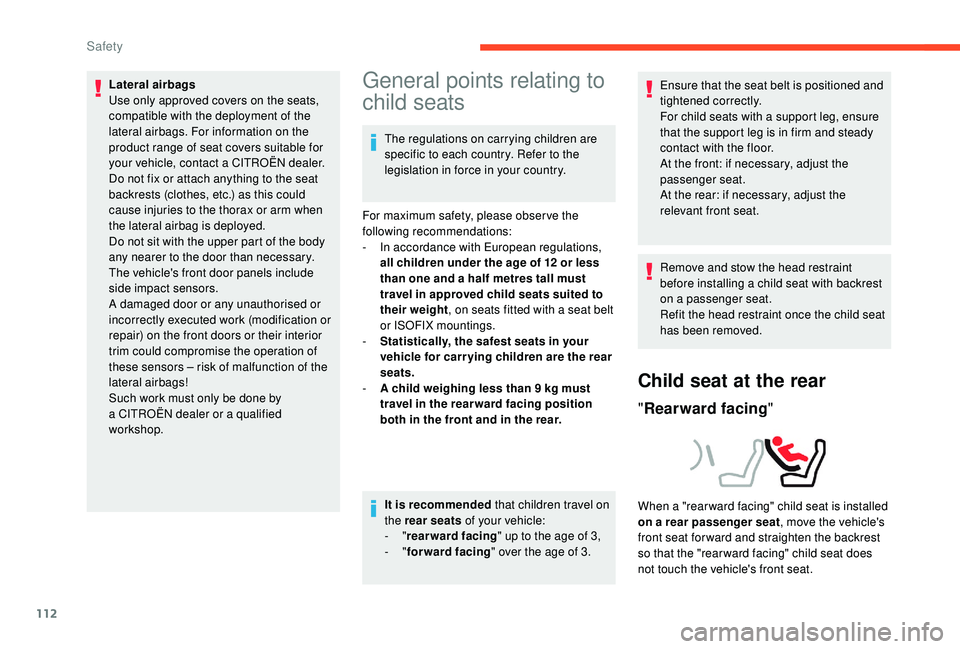
112
Lateral airbags
Use only approved covers on the seats,
compatible with the deployment of the
lateral airbags. For information on the
product range of seat covers suitable for
your vehicle, contact a CITROËN dealer.
Do not fix or attach anything to the seat
backrests (clothes, etc.) as this could
cause injuries to the thorax or arm when
the lateral airbag is deployed.
Do not sit with the upper part of the body
any nearer to the door than necessary.
The vehicle's front door panels include
side impact sensors.
A damaged door or any unauthorised or
incorrectly executed work (modification or
repair) on the front doors or their interior
trim could compromise the operation of
these sensors – risk of malfunction of the
lateral airbags!
Such work must only be done by
a
CITROËN dealer or a qualified
workshop.General points relating to
child seats
The regulations on carrying children are
specific to each country. Refer to the
legislation in force in your country.
For maximum safety, please obser ve the
following recommendations:
-
I
n accordance with European regulations,
all children under the age of 12
or less
than one and a
half metres tall must
travel in approved child seats suited to
their weight , on seats fitted with a
seat belt
or ISOFIX mountings.
-
S
tatistically, the safest seats in your
vehicle for carr ying children are the rear
seats.
-
A c
hild weighing less than 9 kg must
travel in the rear ward facing position
both in the front and in the rear.
It is recommended that children travel on
the rear seats of your vehicle:
-
"rearward facing " up to the age of 3,
-
"forward facing " over the age of 3. Ensure that the seat belt is positioned and
tightened correctly.
For child seats with a
support leg, ensure
that the support leg is in firm and steady
contact with the floor.
At the front: if necessary, adjust the
passenger seat.
At the rear: if necessary, adjust the
relevant front seat.
Remove and stow the head restraint
before installing a
child seat with backrest
on a
passenger seat.
Refit the head restraint once the child seat
has been removed.
Child seat at the rear
" Rearward facing"
When a "rear ward facing" child seat is installed
on a
rear passenger seat , move the vehicle's
front seat for ward and straighten the backrest
so that the "rear ward facing" child seat does
not touch the vehicle's front seat.
Safety
Page 115 of 316

113
"Forward facing "
When a "for ward facing" child seat is installed
on a
rear passenger seat , move the vehicle's
front seat for ward and straighten the backrest
so that the legs of the child in the "for ward
facing" child seat do not touch the vehicle's
front seat.
3rd row seats
Child seat at the front
" Rearward facing"
When a "rear ward facing" child seat is installed
on the front passenger seat , adjust the
vehicle's seat to the intermediate longitudinal
and lowest position, with the backrest
straightened. Then pull the booster/height
adjuster control 11
times.
The front passenger airbag must be
deactivated. Otherwise, the child risks
being seriously injured or killed in case
of airbag deployment .
"Forward facing "
When a "for ward facing" child seat is
installed on the front passenger seat ,
adjust the vehicle's seat to the intermediate
longitudinal and lowest position, with the
backrest straightened. Then pull the booster/
height adjuster control 11
times. Leave the
passenger's airbag active. Passenger seat adjusted into the intermediate
longitudinal and lowest position, then the
booster/height adjuster control pulled 11
times.
When a
child seat is installed on a
rear
passenger seat in the 3
rd row , move the
seats in the 2nd row for ward and straighten the
backrest so that the child seat and the child's
legs do not touch the seat in the 2
nd row.
A child seat with a
support leg must never be
installed on a r ear passenger seat in the 3rd
row ,
Deactivating the front
passenger airbag
Never install a "rear ward facing" child
r estraint system on a seat protected by an
active front airbag. This could cause the
death of the child or serious injury.
5
Safety
Page 119 of 316
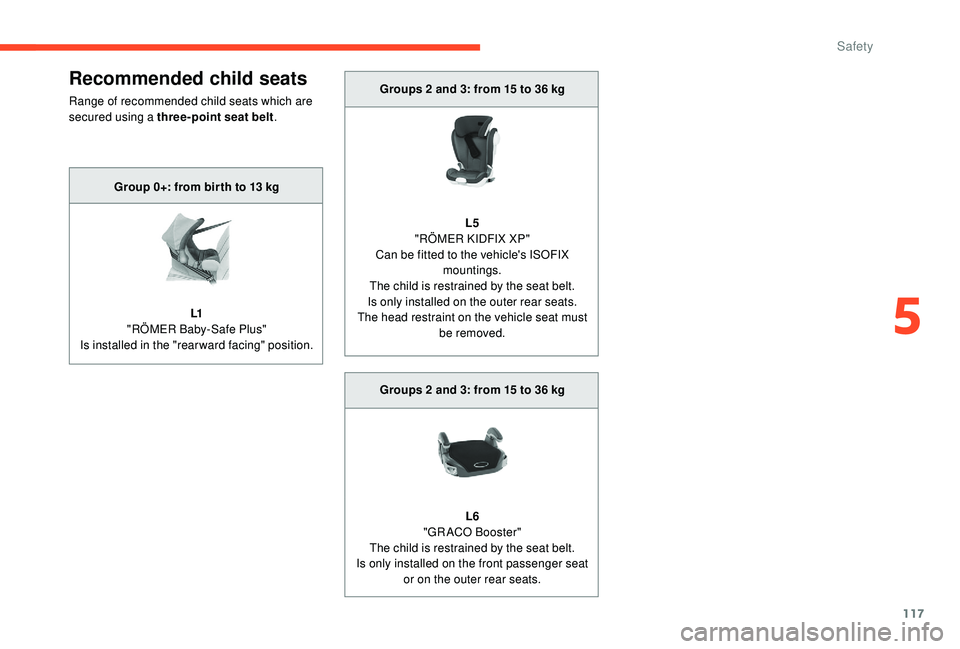
117
Recommended child seats
Range of recommended child seats which are
secured using a three-point seat belt .Groups 2
and 3: from 15 to 36 kg
L5
"RÖMER KIDFIX XP"
Can be fitted to the vehicle's ISOFIX mountings.
The child is restrained by the seat belt.
Is only installed on the outer rear seats.
The head restraint on the vehicle seat must be removed.
Group 0+: from bir th to 13
kg
L1
"RÖMER Baby-Safe Plus"
Is installed in the "rearward facing" position.
Groups 2
and 3: from 15 to 36 kg
L6
"GRACO Booster"
The child is restrained by the seat belt.
Is only installed on the front passenger seat or on the outer rear seats.
5
Safety
Page 120 of 316

118
Installing a child seat attached with the seat belt
In accordance with European regulations, this table indicates the options for installing child seats secured using the seat belt and universally approved
(a ) in relation to the weight of the child and the seat in the vehicle.
Weight of the child/indicative age
Seat position Groups 0 (b) and 0+)
Bir th to 13
kgGroup 1
9 -18
kgGroup 2
15 -25
kgGroup 3
22-36
kg
1
st row Front passenger seat (
c)
- fixed UUUU
-
h
eight adjustable U(R)U(R)U(R)U(R)
2
nd row Fixed outer rear seats and
centre rear seat ( d)
Longitudinally-adjustable outer rear seats ( d) ( e) U
UUU
3
rd row Outer rear seats UUUU
(a) Universal child seat: child seat that can
be installed in all vehicles using the
seat belt. (b)
Group 0: from birth to 10
kg. Infant
car seats and "car cots" cannot be
installed on the front passenger seat or
in the 3
rd row. When installed in the 2nd
row, they may prevent the use of the
other seats. (c)
Refer to the current legislation in your
country before installing your child on
this seat.
Safety
Page 121 of 316
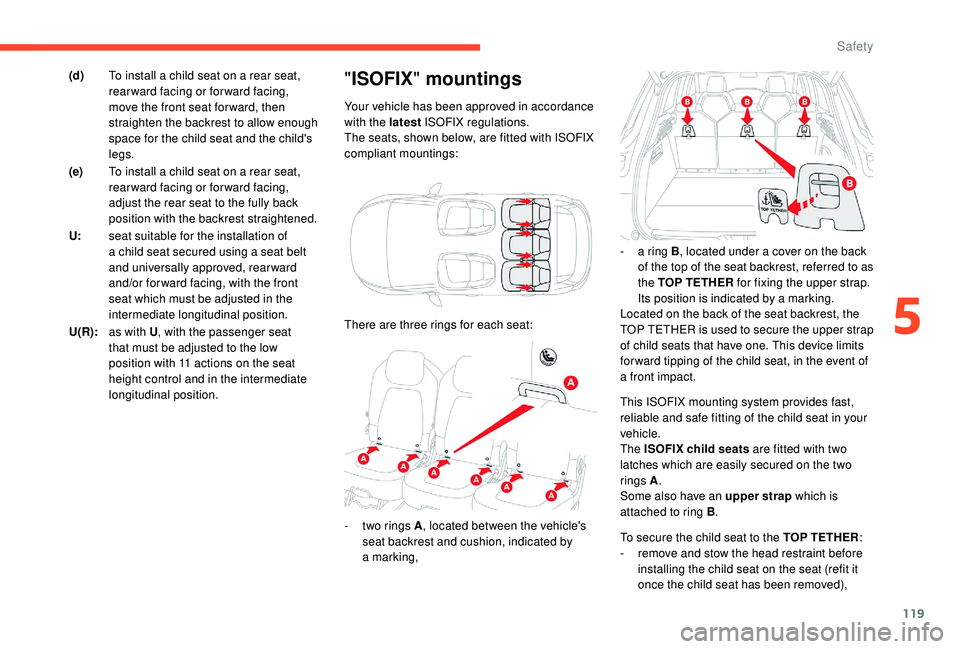
119
This ISOFIX mounting system provides fast,
reliable and safe fitting of the child seat in your
vehicle.
The ISOFIX child seats are fitted with two
latches which are easily secured on the two
rings A.
Some also have an upper strap which is
attached to ring B .
"ISOFIX " mountings
Your vehicle has been approved in accordance
with the latest ISOFIX regulations.
The seats, shown below, are fitted with ISOFIX
compliant mountings:
(d)
To install a
child seat on a
rear seat,
rearward facing or forward facing,
move the front seat for ward, then
straighten the backrest to allow enough
space for the child seat and the child's
legs.
(e) To install a
child seat on a
rear seat,
rearward facing or forward facing,
adjust the rear seat to the fully back
position with the backrest straightened.
U: seat suitable for the installation of
a
child seat secured using a
seat belt
and universally approved, rearward
and/or for ward facing, with the front
seat which must be adjusted in the
intermediate longitudinal position.
U(R): as with U , with the passenger seat
that must be adjusted to the low
position with 11
actions on the seat
height control and in the intermediate
longitudinal position. There are three rings for each seat:
-
t
wo rings A , located between the vehicle's
seat backrest and cushion, indicated by
a
marking, -
a r
ing B, located under a
cover on the back
of the top of the seat backrest, referred to as
the TOP TETHER for fixing the upper strap.
Its position is indicated by a
marking.
Located on the back of the seat backrest, the
TOP TETHER is used to secure the upper strap
of child seats that have one. This device limits
for ward tipping of the child seat, in the event of
a
front impact.
To secure the child seat to the TOP TETHER :
-
r
emove and stow the head restraint before
installing the child seat on the seat (refit it
once the child seat has been removed),
5
Safety
Page 122 of 316
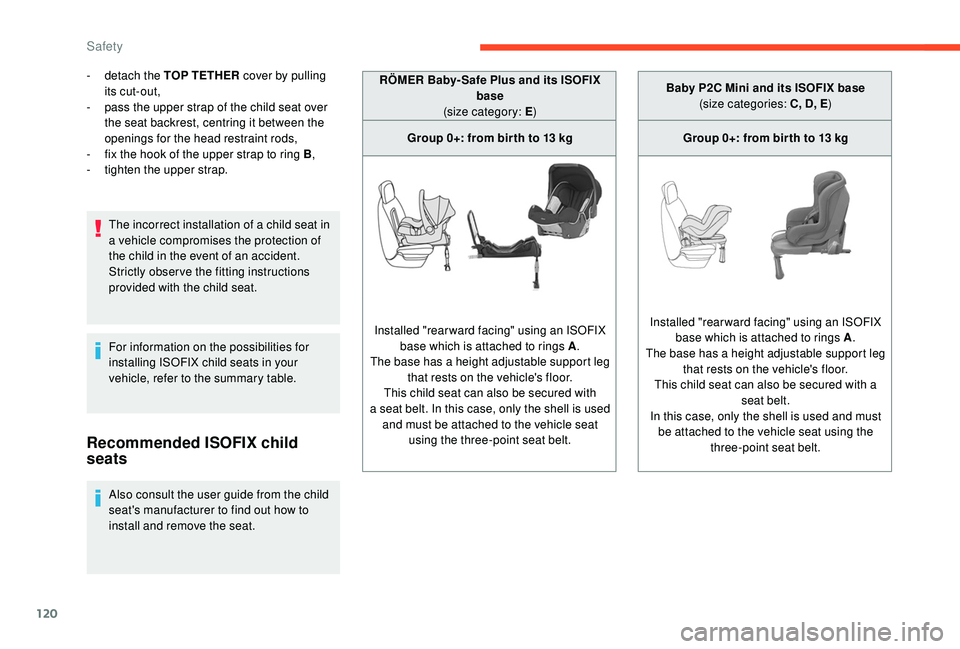
120
- detach the TOP TETHER cover by pulling its cut-out,
-
p
ass the upper strap of the child seat over
the seat backrest, centring it between the
openings for the head restraint rods,
-
f
ix the hook of the upper strap to ring B ,
-
t
ighten the upper strap.The incorrect installation of a
child seat in
a
vehicle compromises the protection of
the child in the event of an accident.
Strictly obser ve the fitting instructions
provided with the child seat.
For information on the possibilities for
installing ISOFIX child seats in your
vehicle, refer to the summary table.
Recommended ISOFIX child
seats
Also consult the user guide from the child
seat's manufacturer to find out how to
install and remove the seat. RÖMER Baby- Safe Plus and its ISOFIX
base
(size category: E )
Group 0+: from bir th to 13 kg
Installed "rearward facing" using an ISOFIX base which is attached to rings A .
The base has a height adjustable support leg
that rests on the vehicle's floor.
This child seat can also be secured with
a seat belt. In this case, only the shell is used
and must be attached to the vehicle seat using the three-point seat belt. Baby P2C Mini and its ISOFIX base
(size categories: C, D, E )
Group 0+: from bir th to 13 kg
Installed "rearward facing" using an ISOFIX base which is attached to rings A .
The base has a height adjustable support leg that rests on the vehicle's floor.
This child seat can also be secured with a seat belt.
In this case, only the shell is used and must be attached to the vehicle seat using the three-point seat belt.
Safety
Page 123 of 316
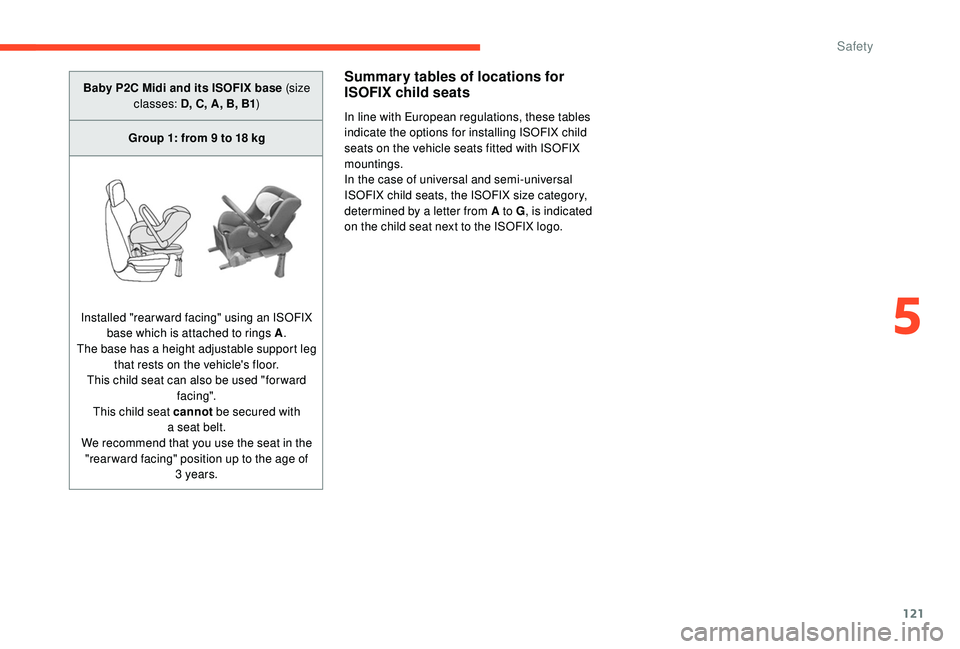
121
Baby P2C Midi and its ISOFIX base (size classes: D, C, A, B, B1 )
Group 1: from 9
to 18 kg
Installed "rearward facing" using an ISOFIX base which is attached to rings A .
The base has a height adjustable support leg that rests on the vehicle's floor.
This child seat can also be used "for ward fac ing".
This child seat cannot be secured with
a
seat belt.
We recommend that you use the seat in the "rear ward facing" position up to the age of 3
years.Summary tables of locations for
ISOFIX child seats
In line with European regulations, these tables
indicate the options for installing ISOFIX child
seats on the vehicle seats fitted with ISOFIX
mountings.
In the case of universal and semi-universal
ISOFIX child seats, the ISOFIX size category,
determined by a letter from A to G , is indicated
on the child seat next to the ISOFIX logo.
5
Safety